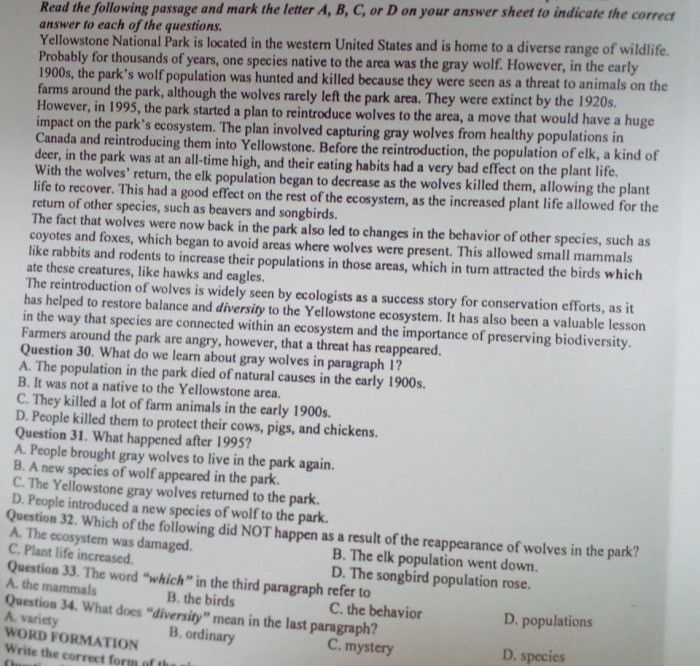Question 30. What do we learn about gray wolves in paragraph 1? A. The population in the park died of natural causes in the early 1900s. B. It was not native to the Yellowstone area. C. They killed a lot of farm animals in the early 1900s. D. People killed them to protect their cows, pigs, and chickens.
Answer: D. People killed them to protect their cows, pigs, and chickens.
Question 31. What happened after 1995? A. People brought gray wolves to live in the park again. B. A new species of wolf appeared in the park. C. The Yellowstone gray wolves returned to the park. D. People introduced a new species of wolf to the park.
Answer: A. People brought gray wolves to live in the park again.
Question 32. Which of the following did NOT happen as a result of the reappearance of wolves in the park? A. The ecosystem was damaged. B. The elk population went down. C. Plant life increased. D. The songbird population rose.
Answer: A. The ecosystem was damaged.
Question 33. The word "which" in the third paragraph refers to A. the mammals B. the behavior C. the birds D. the species
Answer: B. the behavior
Question 34. What does "diversity" mean in the last paragraph? A. variety
Answer: A. variety
Trang chủ
Giải bài tập Online
Đấu trường tri thức
Dịch thuật
Flashcard - Học & Chơi
Cộng đồng
Trắc nghiệm tri thức
Khảo sát ý kiến
Hỏi đáp tổng hợp
Đố vui
Đuổi hình bắt chữ
Quà tặng và trang trí
Truyện
Thơ văn danh ngôn
Xem lịch
Ca dao tục ngữ
Xem ảnh
Bản tin hướng nghiệp
Chia sẻ hàng ngày
Bảng xếp hạng
Bảng Huy hiệu
LIVE trực tuyến
Đề thi, kiểm tra, tài liệu học tập








 Trả lời nhanh trong
Trả lời nhanh trong 



 Xem thêm
Xem thêm  Thưởng th.11.2024
Thưởng th.11.2024 Bảng xếp hạng
Bảng xếp hạng